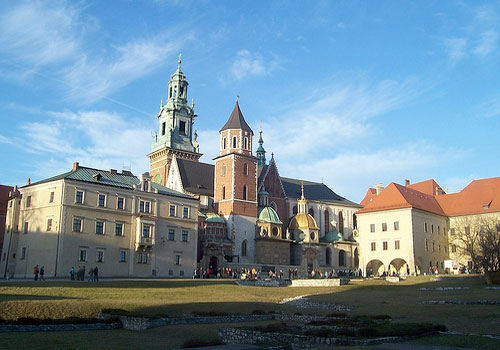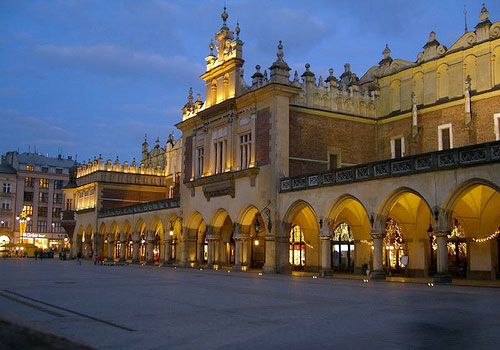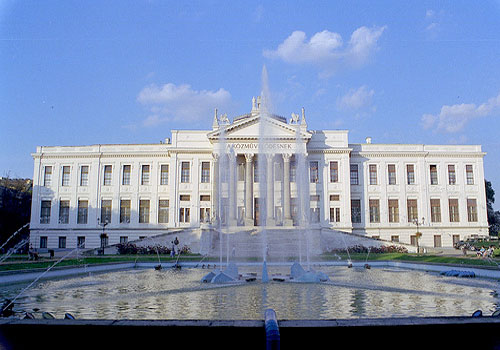Krakow Travel Guide
Main Market Square (Rynek Glówny)
Address: Krakow
Dating from 1257, the Central Market Square was one of the largest squares in Medieval Europe, and remains the social heart of Krakow today. Surrounded by historic buildings, museums and magnificent churches, the impressive expanse of flagstones is a hub of commercial and social activity. Flower sellers, ice-cream vendors, musicians, pigeons, students and groups of tourists fill the square.<br /><br /> Occupying the centre of the square is the splendid medieval Cloth Hall, a covered arcade with a soaring, vaulted interior where merchants once sold their wares. Today, it is filled with lively market stalls. The upstairs art gallery houses a collection of 19th-century Polish paintings and sculptures. Along the outside walls of the building there are elegant terrace cafes. Most famous of these is Noworolski, which was the centre of Krakow social life before the war (Lenin was a notorious regular). The cafe has now regained its reputation as the prime cake and coffee venue in the city.<br /><br /> The most striking church on the square is St Mary's, an impressive twin-spire Gothic structure. Every hour a mournful bugle sounds from the tallest church spire in memory of the lone watchman whose trumpeted warning of an invasion was cut off mid-note by a Turkish arrow in the throat. Within is the famous carved wooden altar, a majestic piece of Gothic art.<br /><br />
Wawel
Address: Krakow
Overlooking the city of Krakow is Wawel, a hill topped with the fascinating architectural complex that includes Wawel Castle and beside it, the gothic Wawel Cathedral. It was here that all the Polish kings ruling between the 14th and the 17th centuries were crowned and buried, and it lies at the heart of Poland's royal history.<br /><br /> The Renaissance-style Royal Castle is now a museum, and the historic interior houses an astonishing collection of treasures from the Polish monarchy, including tapestries, period furniture and paintings. Visitors can see the Royal Private Apartments, Crown Treasury, Armoury, and the State Rooms. The Royal Cathedral was the coronation and burial site of all of Poland's monarchs, many of whom are interred in the Royal Tombs. Of the many royal chapels, the golden-domed renaissance Chapel of King Sigismund is the finest. The bell tower can be climbed for views over the city and to see the enormous 11 tonne bell housed within.<br /><br /> There is no joint ticket allowing access to the whole complex on Wawel Hill and tickets must be bought for individual exhibitions and attractions. A number of different guided tours are available - check the official website listed below for details.<br /><br />
Kazimierz District and the Old Synagogue
Address: Szeroka 24, 31-053 Kraków, Poland Krakow
Telephone: +48 12 431 05 45
Once a separate town and now an inner suburb of Krakow, the Kazimierz quarter was the centre of Jewish religion, culture and learning, and the home of the city's large Jewish population before the war. Badly damaged during the Nazi occupation, with most of the residents either killed or deported to the nearby Holocaust death camps, today it has been rebuilt so visitors can admire the historical architecture and get an experience of what daily Jewish life was once like.<br /><br /> Renewed interest in the district was sparked by Steven Spielberg's film Schindler's List which was set in Kazimierz, and the Jewish culture of the area is being enlivened by art galleries, kosher restaurants and numerous cultural events. The Oskar Schindler Factory Museum is itself a popular tourist attraction in Krakow, dedicated to the memory of Schindler and the Jewish workers he managed to save from the death camps; the museum is housed in the actual enamelware factory once owned by Schindler.<br /><br /> The Old Synagogue is part of the Historical Museum of Krakow, and houses a permanent exhibition titled 'Tradition and Culture of Polish Jews', where the collection of physical memories from the Kazimierz Jewish community is kept.<br /><br />
Wieliczka Salt Mine
Address: Ul. Danilowicza 10, Wieliczka Krakow
The Salt Mine at Wieliczka is a unique underground complex that has been in continuous use since its construction in the Middle Ages, and is now a UNESCO World Cultural Heritage Monument. The series of labyrinthine tunnels, chambers, galleries and underground lakes are spread over nine levels and reach a depth of more than 1,000ft (304m), but visitors are restricted to a tour of three levels.<br /><br /> Following winding passageways, hand-hewn between the 17th and 19th centuries, visitors are guided to magnificently carved chapels, past salt sculptures created by previous mine workers and through huge crystalline caverns. Among the chambers is the oldest creation in the mine, the 17th-century solid salt Chapel of St Anthony. The highlight of the tour is the Blessed Kinga Chapel, dedicated to the patron saint of Polish mine workers. Everything in this huge, ornate chapel is carved from salt, including the altar and chandeliers, and the walls are covered in beautiful sculptured pictures. A dark, clanking lift whisks visitors back to the surface at the end of the guided tour.<br /><br /> The world's first subterranean therapeutic sanatorium is situated 656ft (200m) below the surface, and makes use of the saline air for the treatment of asthma. There is also a Salt-Works Museum that documents the history of the mine and the local geological formation, with primitive mining tools and machines on display.<br /><br />
Auschwitz Memorial Museum
Address: Więźniów Oświęcimia 20, 32-603 Oświęcim, Poland. Krakow
Admission: 8am to 3pm, Monday to Sunday.
Telephone: +48 33 844 81 00
The Auschwitz concentration camp is actually made up of three camps - Auschwitz I, Auschwitz II-Birkenau and Auschwitz III. Together the complex forms the largest cemetery in the world, preserved as a sombre memorial to the victims of the Holocaust, and commemorating the hundreds of thousands of people exterminated there by the Nazis during the Second World War. The Auschwitz-Birkenau Museum was established in 1947 and visitors have access to both camps and can wander freely around the structures, ruins and gas chambers, and visit the exhibits displayed in the surviving prison blocks at Auschwitz I.<br /><br /> The hushed atmosphere is one of shock from the moment visitors enter the barbed-wire compound through the iron gate, ironically inscribed with the words 'Arbeit Macht Frei' (Work Makes Free). The buildings contain displays of photographs and horrific piles of personal articles of the victims, including battered suitcases, and thousands of spectacles, hair and shoes collected from the bodies. The experience is vivid and disturbing, though also deeply humanising. There are general exhibitions dedicated to the Jews and their history, as well as an interesting documentary film screened in the museum's cinema.<br /><br /> Birkenau sees far fewer tourists as it has fewer visitor facilities and much of the camp was destroyed by the retreating Nazis, but it is here that the sheer scale of the tragedy can be experienced, with a viewing platform to give some perspective over the vast fenced-in area stretching as far as the eye can see. Birkenau was the principal camp where the extermination of millions took place, a chillingly efficient set-up with rows of barracks and four colossal gas chambers and ovens. Purpose-built railway tracks lead through the huge gateway, terminating in the camp, with which victims were transported from the ghettos to the camp in crowded box-like carts, often being led straight into the gas chambers upon arrival. A trip to the Auschwitz Memorial Museum is a must for any visitor to Poland who wishes to experience some kind of sobering communion with one of the greatest atrocities in the history of the world.<br /><br /> Taking a guided tour of the camps is the best way to fully comprehend what you are seeing and a tour takes at least three and a half hours. Visitors should try and book a place on one of the various guided tours at least two weeks before visiting - see the official website below for details.<br /><br />
Galicia Jewish Museum
Address: Dajwór 18, 31-052 Kraków, Poland. Krakow
Admission: 10am to 6pm, Monday to Sunday.
Telephone: +48 12 421 68 42
Situated in the heart of Kazimierz, the Jewish Quarter of Krakow, the Galicia Jewish Museum houses a permanent photographic exhibition called "Traces of Memory" which is extremely powerful and interesting. The exhibition documents the history of the Jewish people in the villages and towns of Poland, particularly documenting the Holocaust; Poland lost almost a quarter of its population in World War II, and the Jewish community was decimated.<br /><br /> This poignant museum also hosts plenty of temporary exhibitions, a range of special events, lectures and Jewish music concerts and has a well-stocked bookshop. The museum is a registered charity in Poland and the UK and aims to discourage negative stereotypes and misconceptions about the Jews in Poland and educate the public about Jewish history and heritage. The museum is housed in a wonderful building that is an attraction in itself and the exhibitions are very well organised and presented.<br /><br /> The Galicia Jewish Museum is often overlooked as a tourist attraction in Krakow, but is a worthwhile experience for people from all walks of life. Budget at least three hours to fully absorb the experience. Guided tours are available and there is a charming little cafe for refreshments.<br /><br />
Piwnica pod Baranami
Address: Main Market Square, Krakow. Krakow
A visit to the Piwnica pod Baranami ('Cellar Under the Rams') - a Parisian-style cabaret house located in Krakow's Old Town district - is probably the shortest route tourists can take to experiencing the culture of the city, and to gaining an appreciation for its most strongly-held values and ideals.<br /><br /> The Piwnica pod Baranami was created by Piotr Skrzynecki in 1956, in a suitably bohemian underground cellar, and soon became a haven for local artists and intellectuals; a place for them to meet, exchange ideas, and indulge in one of Poland's favourite cultural pastimes, the political cabaret. The cabaret's reputation grew throughout the latter half of the 20th Century, and soon became a symbol for the eccentricity (and indeed, the stifled talent) of the local artists of the area. The Piwnica pod Baranami still functions as a cabaret house to this day: performances are on Saturdays at 9pm and remain extremely popular, so book your ticket early.<br /><br /> This is a highly recommended tourist activity in Poland, and a great place to begin an unforgettable Saturday night out on the town in Krakow. The cellar sometimes closes for a summer break in July - check the official website listed below for more details.<br /><br />
Bieszczady Mountains
Address: Krakow
While most tourists to Poland stick to the cities and content themselves with the wonderful cultural experiences in the old towns of Warsaw and Krakow, a trip into the Polish countryside - and particularly, the southern Bieszczady Mountains - is a very rewarding enterprise. Bieszczady is a mountain range that runs through the extreme southeast of Poland, near the borders with Ukraine and Slovakia.<br /><br /> A land of snow-capped peaks, tall pine trees, vast green meadows and a rich array of native flora and fauna, the Bieszczady area is not only gorgeous, but offers plenty of well-maintained hiking and mountain biking trails, many of them wending their way through the UNESCO East Carpathian Biosphere Reserve. Animal lovers should look out for the lynxes, bears and wolves that can be found in the mountains.<br /><br /> Apart from all this natural bounty, the Polish countryside is known for its human inhabitants: the internet is awash with tourist tales of being invited to share trout barbecues with friendly local families, of stumbling across eccentric villages and towns, and of snapping photograph after photograph of rural houses that look like they have been lifted straight out of Grimm's Fairy Tales.<br /><br />
(Data provided outside US and Canada by Foreca, Data provided for US and Canada by WDT)
| Jan | Feb | Mar | Apr | May | Jun | Jul | Aug | Sep | Oct | Nov | Dec | |
| Average High | 0° | 1° | 7° | 12° | 17° | 20° | 21° | 21° | 17° | 12° | 5° | 2° |
| Average Low | -5° | -4° | 0° | 3° | 7° | 11° | 12° | 12° | 8° | 4° | 0° | -3° |
| Chances of Sun | 0 | 0 | 1 | 4 | 14 | 19 | 24 | 23 | 12 | 5 | 0 | 0 |
| Average Rainy Days | 18 | 17 | 15 | 15 | 15 | 16 | 14 | 13 | 13 | 13 | 17 | 20 |
(Data provided outside US and Canada by Foreca, Data provided for US and Canada by WDT)
| Jan | Feb | Mar | Apr | May | Jun | Jul | Aug | Sep | Oct | Nov | Dec | |
| Average High | 33° | 35° | 45° | 54° | 64° | 69° | 71° | 71° | 64° | 55° | 42° | 36° |
| Average Low | 22° | 24° | 31° | 38° | 46° | 52° | 55° | 54° | 48° | 40° | 32° | 26° |
| Chances of Sun | 0 | 0 | 1 | 4 | 14 | 19 | 24 | 23 | 12 | 5 | 0 | 0 |
| Average Rainy Days | 18 | 17 | 15 | 15 | 15 | 16 | 14 | 13 | 13 | 13 | 17 | 20 |
| Description Round pins. |
Voltage 230 V |
Frequency 50 Hz |
Type C |
| Description Round pins, grounding pin and receptacle. |
Voltage 230 V |
Frequency 50 Hz |
Type E |



